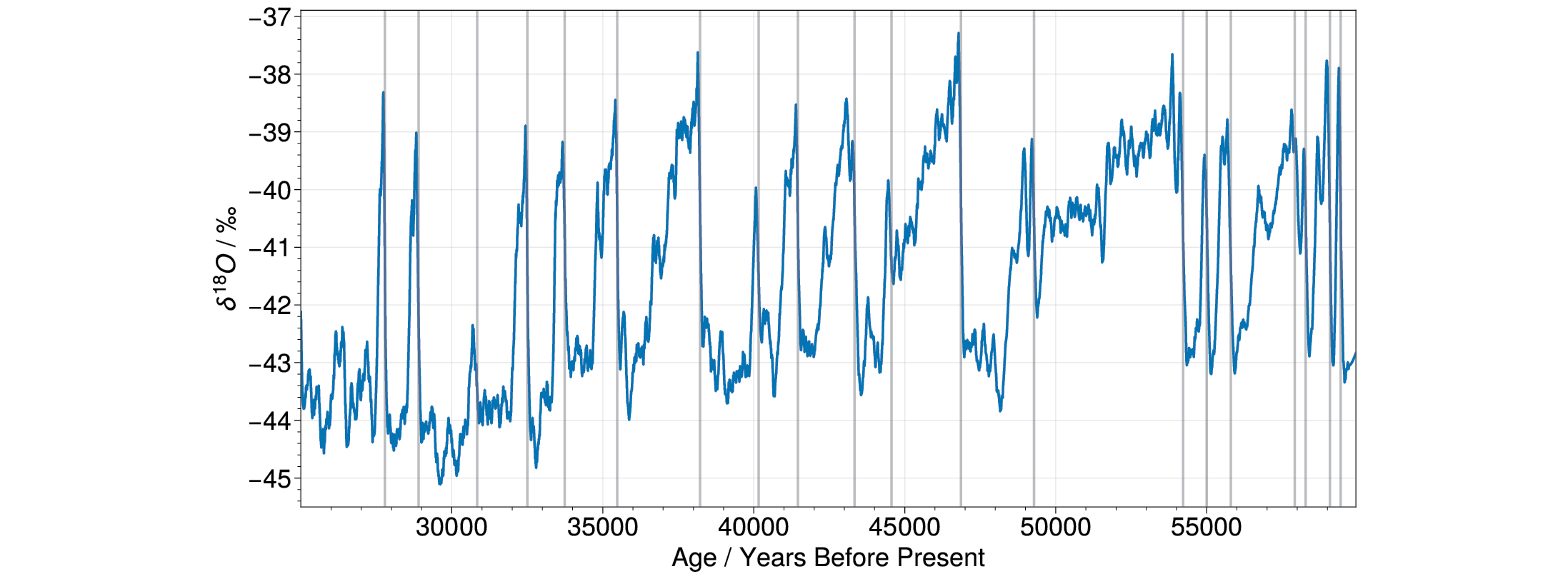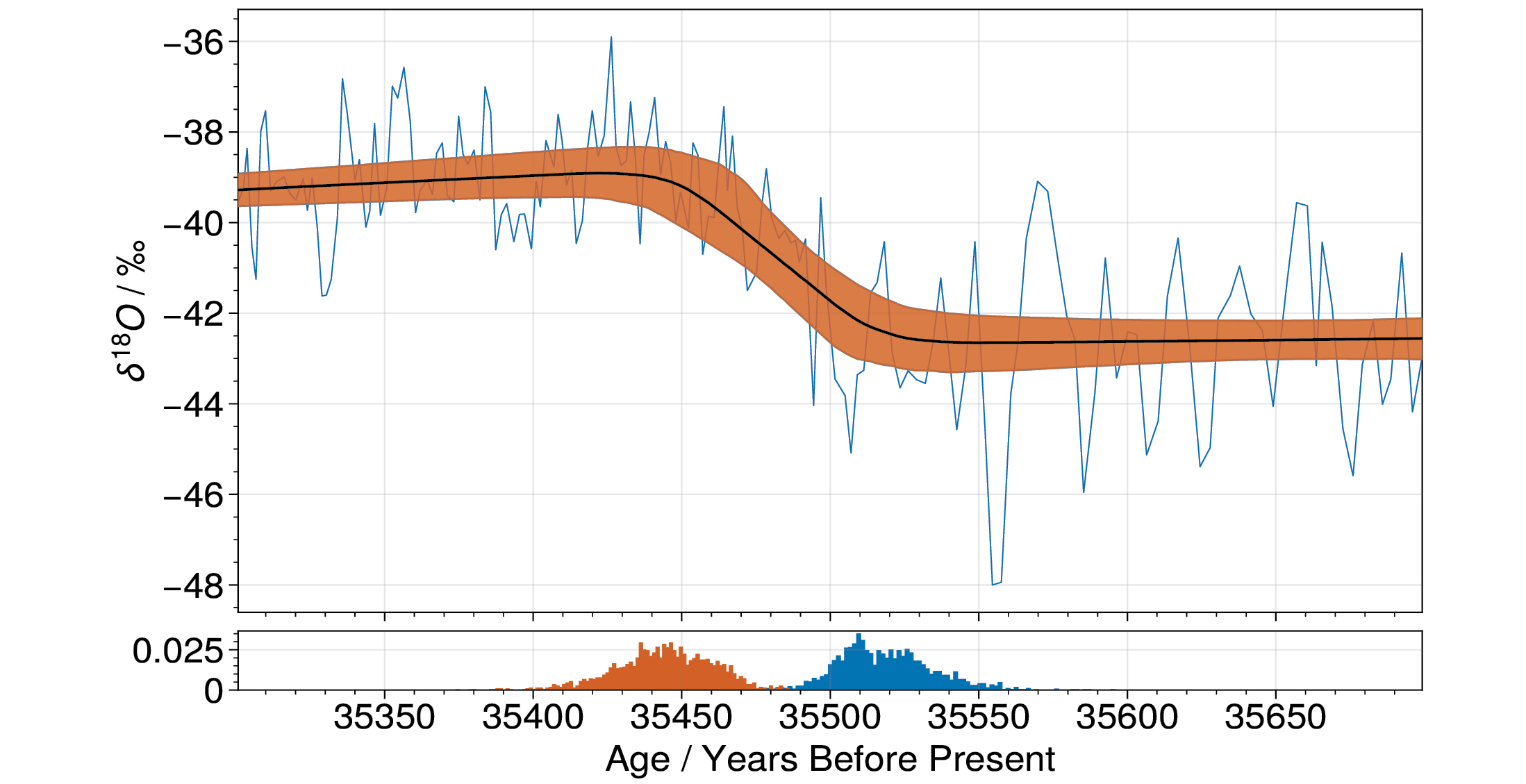- Home
- Publications
- PAGES Magazine
- Searching For The Secrets of Tipping Points In Greenland Ice Cores
Searching for the secrets of tipping points in Greenland ice cores
John Slattery and Louise C. Sime
Past Global Changes Magazine
31(2)
110-111
2023
Greenland ice cores provide high-resolution records of Dansgaard–Oeschger events – abrupt climate transitions, which happened repeatedly during the last glacial. These records can allow us to understand past climate tipping behaviour and to predict possible future tipping points.
Climate tipping points
The ability for society to reliably forecast future anthropogenic climate change is challenged by the likely presence of climate tipping points. These are hypothesized thresholds of global warming at which certain subsystems within the Earth’s climate, known as tipping elements, may undergo sudden and irreversible change in a process called a critical transition. Potential tipping elements that have been identified include the West Antarctic Ice Sheet, the Amazon Rainforest, and the Atlantic Meridional Overturning Circulation (AMOC) (Armstrong McKay et al. 2022, Wunderling et al. 2021). Were any of these elements to tip in future, it would lead to dramatic regional or global climate change, making this an extremely policy-relevant concern (Armstrong McKay et al. 2022). Furthermore, interactions between tipping elements raise the possibility of a disastrous cascade, with a domino-like effect allowing one abrupt change to lead to several more (Wunderling et al. 2021). Thus, quantifying the likelihood of passing a tipping point in the future has become a major focus of climate research.
Dansgaard–Oeschger Events
Dansgaard–Oeschger, or DO, warming events are a series of abrupt transitions in the climate between colder Greenland stadials and warmer Greenland interstadials that occurred repeatedly during the last glacial. These events were first observed in stable water-isotope records from Greenland ice cores, as shown in Figure 1. These stable isotope records show abrupt changes that suggest warming of up to 15°C in just a few decades (Kindler et al. 2014). This extreme rate of warming makes DO events the fastest instances of regional temperature change seen in the paleoclimate record, and so they are seen as the epitome of abrupt climate transitions. As well as the rapid warming inferred by stable water isotopes, Greenland ice cores show transitions in the annual layer thickness, as well as the concentrations of sea salt and mineral aerosols (Capron et al. 2021), respectively suggesting abrupt changes in precipitation, sea-ice extent, and atmospheric circulation in the North Atlantic region. Therefore, these ice cores contain a wealth of information about the climate changes that occur during DO events.
Beyond pure scientific curiosity, there are very practical and pressing reasons to be interested in DO events. There is compelling evidence that DO events are themselves the consequences of a tipping point being crossed (Boers 2018), in this case not because of human actions, but instead due to gradual internal changes within the climate system. A consensus has developed that at the heart of DO events lie transitions between strong and weak states of the AMOC (Li and Born 2019; Malmierca-Vallet et al. 2023; Vettoretti et al. 2022), a crucial system of ocean currents that transports large amounts of heat towards higher latitudes in the Northern Hemisphere and is possibly approaching a tipping point (Armstrong McKay et al. 2022). This hypothesized tipping point would be driven by different mechanisms to those involved in DO events, thus we cannot draw direct comparisons. Nevertheless, this possibility means that it is imperative that we develop a deeper understanding of past tipping behavior, as seen in DO events, such that we stand the best possible chance of understanding potential future critical transitions.
Greenland is, undoubtedly, where the best records of DO events are found, but their signatures can be seen further afield too. Approximately simultaneous with the local changes in surface temperature, precipitation, and sea-ice extent recorded in Greenland ice cores, speleothem records from East Asia and Atlantic marine-sediment cores show abrupt transitions in the large-scale atmospheric (Wang et al. 2008) and oceanic (Lynch-Stieglitz 2017) circulations. These changes are all intertwined due to a complex set of feedbacks between the three key components of ocean, atmosphere, and sea ice (Li and Born 2019; Malmierca-Vallet et al. 2023). The picture that emerges is a cascade of transitions, with an initial transition in one climate element leading to a transition in the next, and so on. What remains very unclear is the order of this cascade. Particularly important is the question of which element begins this cascade. Based on our current knowledge, we cannot rule out any of the three key climate components previously mentioned, or even narrow down the location. Every imaginable answer to this question has been suggested, with different researchers often arriving at different conclusions using simulations from the exact same model (Kleppin et al. 2015; Vettoretti et al. 2022)! At the same time, locating the start of this chain of causality is needed before we can be certain of the mechanism responsible for triggering DO events – which is ultimately the aim of this field of research.
Systematic timing differences
It is clear that a new approach is needed to better understand the cascade of transitions that occurs during a DO warming event. One option is to search for systematic timing differences between the different climate elements which show rapid change; a line of research for which Greenland ice cores are uniquely suited. A single ice core can provide independent measurements of multiple species associated with different components of the climate system at sub-decadal time resolution within a single archive, getting around the problem of dating uncertainties, which makes timing comparisons between different paleoclimate archives so difficult (Capron et al. 2021). The measurements that have been used to investigate the temporal phasing of DO events are the mineral-dust aerosol (Ca2+) and sea-salt aerosol (Na+) content from both the North Greenland Ice Core Project (NGRIP) and North Greenland Eemian (NEEM) ice cores, as well as the annual layer thickness (λ) and the water-isotope ratio (δ18O). These four measurements are respectively interpreted as reflecting the Northern Hemisphere atmospheric circulation, North Atlantic sea-ice extent, local precipitation rates, and surface-air temperature at the ice-core site (Erhardt et al. 2019). This gives potentially independent data on four climate elements. It is important to note, however, that individual measurements are not always uniquely associated with a single climate element. For example, the δ18O of Greenland ice cores is both reflective of sea-ice change around Greenland, and temperature change at the ice-core site (Sime et al. 2019). For these reasons, whilst ice cores are fantastic archives of DO events, care is required when using these measurements to draw conclusions about the timing of changes across different elements.
Even with the excellent precision that ice-core measurements afford, pinpointing the timing of a tipping point in a noisy climate record is statistically challenging. The acceptance of this uncertainty, and resultant use of Bayesian inference to produce probabilistic distributions for the start and end times of DO warming events, has been a major step forward (Capron et al. 2021). An example of the application of this type of approach to a DO event in the NGRIP δ18O record is shown in Figure 2. Stacking all the DO events covered by the ice cores, we can then assess the mean differences in timing between the transitions in different core measurements. The first pioneering study to utilize this method indicated that the transitions in Ca2+ and λ systematically led those in Na+ and δ18O (Erhardt et al. 2019), suggesting that atmospheric changes were in fact the first element of the DO warming event cascade, and apparently representing a breakthrough in our understanding.
Subsequent work showed that attempting to estimate the population mean time difference from a relatively small sample of DO events, of which each is itself uncertain, meant that the two-fold uncertainty inherent to this method had been underestimated. Rigorously propagating this uncertainty revealed that the previously reported systematic timing differences were not statistically robust (Riechers and Boers 2021). Thus, the current picture is that the variation between individual DO events is too great, and the rapidity of the element cascade too rapid, for any certainty regarding the sequence of changes to be possible using the measurements currently available from ice cores (Capron et al. 2021). In future, new ice cores, higher resolution measurements, or improved analytical techniques may allow us to make further progress on this crucial problem. But for now, despite giving us tantalizing teases, the ice cores withhold their secrets.
affiliationS
1Ice Dynamics and Paleoclimate, British Antarctic Survey, Cambridge, UK
2Department of Geography, University of Cambridge, UK
contact
John Slattery: johatt11 bas.ac.uk
bas.ac.uk
references
Andersen KK et al. (2004) Nature 431: 147-151
Armstrong McKay D et al. (2022) Science 377: eabn7950
Boers N (2018) Nat Commun 9: 2556
Capron E et al. (2021) Nat Commun 12: 2106
Erhardt T et al. (2019) Clim Past 15: 811-825
Kindler P et al. (2014) Clim Past 10: 887-902
Kleppin H et al. (2015) J Climate 28: 7741-7763
Li C, Born A (2019) Quat Sci Rev 203: 1-20
Lynch-Stieglitz J (2017) Ann Rev of Mar Sci 9: 83-104
Malmierca-Vallet I et al. (2023) Clim Past 19: 915-942
Riechers K, Boers N (2021) Clim Past 17: 1751-1775
Sime LC et al. (2019) Proc Natl Acad Sci 116: 4099-4104
Vettoretti G et al. (2022) Nat Geosci 15: 300-306

